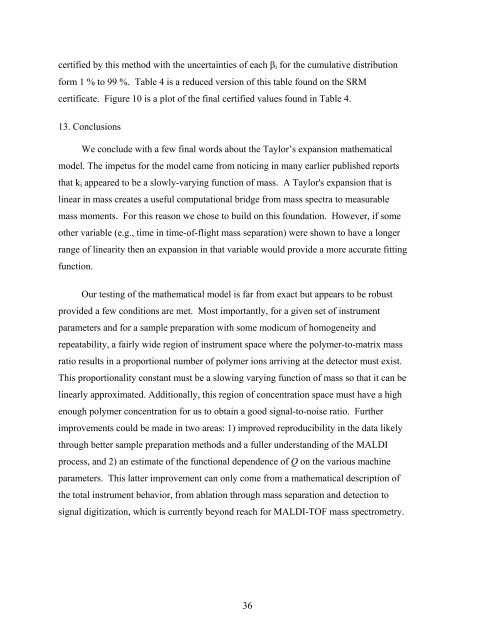Standard Reference Material 2881 - National Institute of Standards ...
Standard Reference Material 2881 - National Institute of Standards ...
Standard Reference Material 2881 - National Institute of Standards ...
Create successful ePaper yourself
Turn your PDF publications into a flip-book with our unique Google optimized e-Paper software.
certified by this method with the uncertainties <strong>of</strong> each β i for the cumulative distributionform 1 % to 99 %. Table 4 is a reduced version <strong>of</strong> this table found on the SRMcertificate. Figure 10 is a plot <strong>of</strong> the final certified values found in Table 4.13. ConclusionsWe conclude with a few final words about the Taylor’s expansion mathematicalmodel. The impetus for the model came from noticing in many earlier published reportsthat k i appeared to be a slowly-varying function <strong>of</strong> mass. A Taylor's expansion that islinear in mass creates a useful computational bridge from mass spectra to measurablemass moments. For this reason we chose to build on this foundation. However, if someother variable (e.g., time in time-<strong>of</strong>-flight mass separation) were shown to have a longerrange <strong>of</strong> linearity then an expansion in that variable would provide a more accurate fittingfunction.Our testing <strong>of</strong> the mathematical model is far from exact but appears to be robustprovided a few conditions are met. Most importantly, for a given set <strong>of</strong> instrumentparameters and for a sample preparation with some modicum <strong>of</strong> homogeneity andrepeatability, a fairly wide region <strong>of</strong> instrument space where the polymer-to-matrix massratio results in a proportional number <strong>of</strong> polymer ions arriving at the detector must exist.This proportionality constant must be a slowing varying function <strong>of</strong> mass so that it can belinearly approximated. Additionally, this region <strong>of</strong> concentration space must have a highenough polymer concentration for us to obtain a good signal-to-noise ratio. Furtherimprovements could be made in two areas: 1) improved reproducibility in the data likelythrough better sample preparation methods and a fuller understanding <strong>of</strong> the MALDIprocess, and 2) an estimate <strong>of</strong> the functional dependence <strong>of</strong> Q on the various machineparameters. This latter improvement can only come from a mathematical description <strong>of</strong>the total instrument behavior, from ablation through mass separation and detection tosignal digitization, which is currently beyond reach for MALDI-TOF mass spectrometry.36
















